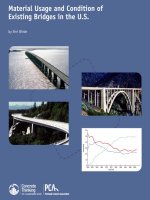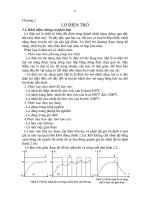Tài liệu material science vol 1 of 2 pptx
Bạn đang xem bản rút gọn của tài liệu. Xem và tải ngay bản đầy đủ của tài liệu tại đây (2.16 MB, 102 trang )
DOE-HDBK-1017/1-93
JANUARY 1993
DOE FUNDAMENTALS HANDBOOK
MATERIAL SCIENCE
Volume 1 of 2
U.S. Department of Energy FSC-6910
Washington, D.C. 20585
Distribution Statement A. Approved for public release; distribution is unlimited.
This document has been reproduced directly from the best available copy.
Available to DOE and DOE contractors from the Office of Scientific and
Technical Information, P.O. Box 62, Oak Ridge, TN 37831.
Available to the public from the National Technical Information Service, U.S.
Department of Commerce, 5285 Port Royal Rd., Springfield, VA 22161.
Order No. DE93012224
DOE-HDBK-1017/1-93
MATERIAL SCIENCE
ABSTRACT
The Material Science Handbook was developed to assist nuclear facility operating
contractors in providing operators, maintenance personnel, and the technical staff with the
necessary fundamentals training to ensure a basic understanding of the structure and properties
of metals. The handbook includes information on the structure and properties of metals, stress
mechanisms in metals, failure modes, and the characteristics of metals that are commonly used
in DOE nuclear facilities. This information will provide personnel with a foundation for
understanding the properties of facility materials and the way these properties can impose
limitations on the operation of equipment and systems.
Key Words: Training Material, Metal Imperfections, Metal Defects, Properties of Metals,
Thermal Stress, Thermal Shock, Brittle Fracture, Heat-Up, Cool-Down, Characteristics of
Metals
Rev. 0 MS
DOE-HDBK-1017/1-93
MATERIAL SCIENCE
FOREWORD
The Department of Energy (DOE) Fundamentals Handbooks consist of ten academic
subjects, which include Mathematics; Classical Physics; Thermodynamics, Heat Transfer, and
Fluid Flow; Instrumentation and Control; Electrical Science; Material Science; Mechanical
Science; Chemistry; Engineering Symbology, Prints, and Drawings; and Nuclear Physics and
Reactor Theory. The handbooks are provided as an aid to DOE nuclear facility contractors.
These handbooks were first published as Reactor Operator Fundamentals Manuals in 1985
for use by DOE category A reactors. The subject areas, subject matter content, and level of
detail of the Reactor Operator Fundamentals Manuals were determined from several sources.
DOE Category A reactor training managers determined which materials should be included, and
served as a primary reference in the initial development phase. Training guidelines from the
commercial nuclear power industry, results of job and task analyses, and independent input from
contractors and operations-oriented personnel were all considered and included to some degree
in developing the text material and learning objectives.
The DOE Fundamentals Handbooks represent the needs of various DOE nuclear facilities'
fundamental training requirements. To increase their applicability to nonreactor nuclear facilities,
the Reactor Operator Fundamentals Manual learning objectives were distributed to the Nuclear
Facility Training Coordination Program Steering Committee for review and comment. To update
their reactor-specific content, DOE Category A reactor training managers also reviewed and
commented on the content. On the basis of feedback from these sources, information that applied
to two or more DOE nuclear facilities was considered generic and was included. The final draft
of each of the handbooks was then reviewed by these two groups. This approach has resulted
in revised modular handbooks that contain sufficient detail such that each facility may adjust the
content to fit their specific needs.
Each handbook contains an abstract, a foreword, an overview, learning objectives, and text
material, and is divided into modules so that content and order may be modified by individual
DOE contractors to suit their specific training needs. Each handbook is supported by a separate
examination bank with an answer key.
The DOE Fundamentals Handbooks have been prepared for the Assistant Secretary for
Nuclear Energy, Office of Nuclear Safety Policy and Standards, by the DOE Training
Coordination Program. This program is managed by EG&G Idaho, Inc.
Rev. 0 MS
DOE-HDBK-1017/1-93
MATERIAL SCIENCE
OVERVIEW
The Department of Energy Fundamentals Handbook entitled Material Science was
prepared as an information resource for personnel who are responsible for the operation of the
Department's nuclear facilities. An understanding of material science will enable the contractor
personnel to understand why a material was selected for certain applications within their facility.
Almost all processes that take place in the nuclear facilities involve the use of specialized metals.
A basic understanding of material science is necessary for DOE nuclear facility operators,
maintenance personnel, and the technical staff to safely operate and maintain the facility and
facility support systems. The information in the handbook is presented to provide a foundation
for applying engineering concepts to the job. This knowledge will help personnel more fully
understand the impact that their actions may have on the safe and reliable operation of facility
components and systems.
The Material Science handbook consists of five modules that are contained in two
volumes. The following is a brief description of the information presented in each module of the
handbook.
Volume 1 of 2
Module 1 - Structure of Metals
Explains the basic structure of metals and how those structures are effected by
various processes. The module contains information on the various imperfections
and defects that the metal may sustain and how they affect the metal.
Module 2 - Properties of Metals
Contains information on the properties considered when selecting material for a
nuclear facility. Each of the properties contains a discussion on how the property
is effected and the metal's application.
Rev. 0 MS
DOE-HDBK-1017/1-93
MATERIAL SCIENCE
OVERVIEW (Cont.)
Volume 2 of 2
Module 3 - Thermal Shock
Contains material relating to thermal stress and thermal shock effects on a system.
Explains how thermal stress and shock combined with pressure can cause major
damage to components.
Module 4 - Brittle Fracture
Contains material on ductile and brittle fracture. These two fractures are the most
common in nuclear facilities. Explains how ductile and brittle fracture are effected
by the minimum pressurization and temperature curves. Explains the reason why
heatup and cooldown rate limits are used when heating up or cooling down the
reactor system.
Module 5 - Plant Materials
Contains information on the commonly used materials and the characteristics
desired when selecting material for use.
The information contained in this handbook is by no means all encompassing. An attempt
to present the entire subject of material science would be impractical. However, the Material
Science
handbook does present enough information to provide the reader with a fundamental
knowledge level sufficient to understand the advanced theoretical concepts presented in other
subject areas, and to better understand basic system operation and equipment operations.
Rev. 0 MS
MATERIAL SCIENCE
Module 1
Structure of Metals
Structure of Metals DOE-HDBK-1017/1-93 TABLE OF CONTENTS
TABLE OF CONTENTS
LIST OF FIGURES ii
LIST OF TABLES iii
REFERENCES iv
OBJECTIVES v
BONDING 1
Atomic Bonding 1
Order in Microstructures 4
Summary 5
COMMON LATTICE TYPES 6
Common Crystal Structures 6
Summary 8
GRAIN STRUCTURE AND BOUNDARY 9
Grain Structure and Boundary 9
Summary 11
POLYMORPHISM 12
Polymorphism Phases 12
Summary 14
ALLOYS 15
Alloys 15
Common Characteristics of Alloys 15
Type 304 Stainless Steel 16
Composition of Common Engineering Materials 16
Summary 17
IMPERFECTIONS IN METALS 18
Microscopic Imperfections 18
Macroscopic Defects 21
Summary 22
Rev. 0 Page i MS-01
LIST OF FIGURES DOE-HDBK-1017/1-93 Structure of Metals
LIST OF FIGURES
Figure 1 Bonding Types 3
Figure 2 Common Lattice Types 7
Figure 3 Grains and Boundaries 10
Figure 4 Grain Orientation 10
Figure 5 Cooling Curve for Unalloyed Uranium 12
Figure 6 Change in Alpha Uranium Upon Heating From 0 to 300°C 13
Figure 7 Point Defects 19
Figure 8 Line Defects (Dislocations) 19
Figure 9 Slips 20
MS-01 Page ii Rev. 0
Structure of Metals DOE-HDBK-1017/1-93 LIST OF TABLES
LIST OF TABLES
Table 1 Examples of Materials and Their Bonds 2
Table 2 Typical Composition of Common Engineering Materials 16
Rev. 0 Page iii MS-01
REFERENCES DOE-HDBK-1017/1-93 Structure of Metals
REFERENCES
Academic Program for Nuclear Power Plant Personnel, Volume III, Columbia, MD,
General Physics Corporation, Library of Congress Card #A 326517, 1982.
Foster and Wright, Basic Nuclear Engineering, Fourth Edition, Allyn and Bacon, Inc.,
1983.
Glasstone and Sesonske, Nuclear Reactor Engineering, Third Edition, Van Nostrand
Reinhold Company, 1981.
Metcalfe, Williams, and Castka, Modern Chemistry, Holt, Rinehart, and Winston, New
York, NY, 1982.
Reactor Plant Materials, General Physics Corporation, Columbia Maryland, 1982.
Savannah River Site, Material Science Course, CS-CRO-IT-FUND-10, Rev. 0, 1991.
Tweeddale, J.G., The Mechanical Properties of Metals Assessment and Significance,
American Elsevier Publishing Company, 1964.
Weisman, Elements of Nuclear Reactor Design, Elsevier Scientific Publishing Company,
1983.
MS-01 Page iv Rev. 0
Structure of Metals DOE-HDBK-1017/1-93 OBJECTIVES
TERMINAL OBJECTIVE
1.0 Without references, DESCRIBE the bonding and patterns that effect the structure of a
metal.
ENABLING OBJECTIVES
1.1 STATE the five types of bonding that occur in materials and their characteristics.
1.2 DEFINE the following terms:
a. Crystal structure
b. Body-centered cubic structure
c. Face-centered cubic structure
d. Hexagonal close-packed structure
1.3 STATE the three lattice-type structures in metals.
1.4 Given a description or drawing, DISTINGUISH between the three most common types
of crystalline structures.
1.5 IDENTIFY the crystalline structure possessed by a metal.
1.6 DEFINE the following terms:
a. Grain
b. Grain structure
c. Grain boundary
d. Creep
1.7 DEFINE the term polymorphism.
1.8 IDENTIFY the ranges and names for the polymorphism phases associated with uranium
metal.
1.9 IDENTIFY the polymorphism phase that prevents pure uranium from being used as fuel.
Rev. 0 Page v MS-01
OBJECTIVES DOE-HDBK-1017/1-93 Structure of Metals
ENABLING OBJECTIVES (Cont.)
1.10 DEFINE the term alloy.
1.11 DESCRIBE an alloy as to the three possible microstructures and the two general
characteristics as compared to pure metals.
1.12 IDENTIFY the two desirable properties of type 304 stainless steel.
1.13 IDENTIFY the three types of microscopic imperfections found in crystalline structures.
1.14 STATE how slip occurs in crystals.
1.15 IDENTIFY the four types of bulk defects.
MS-01 Page vi Rev. 0
Structure of Metals DOE-HDBK-1017/1-93 BONDING
BONDING
The arrangement of atoms in a material determines the behavior and properties
of that material. Most of the materials used in the construction of a nuclear
reactor facility are metals. In this chapter, we will discuss the various types of
bonding that occurs in material selected for use in a reactor facility. The
Chemistry Handbook discusses the bonding types in more detail.
EO 1.1 STATE the five types of bonding that occur in materials and
their characteristics.
Matter, as we know it, exists in three common states. These three states are solid, liquid, and
gas. The atomic or molecular interactions that occur within a substance determine its state. In
this chapter, we will deal primarily with solids because solids are of the most concern in
engineering applications of materials. Liquids and gases will be mentioned for comparative
purposes only.
Solid matter is held together by forces originating between neighboring atoms or molecules.
These forces arise because of differences in the electron clouds of atoms. In other words, the
valence electrons, or those in the outer shell, of atoms determine their attraction for their
neighbors. When physical attraction between molecules or atoms of a material is great, the
material is held tightly together. Molecules in solids are bound tightly together. When the
attractions are weaker, the substance may be in a liquid form and free to flow. Gases exhibit
virtually no attractive forces between atoms or molecules, and their particles are free to move
independently of each other.
The types of bonds in a material are determined by the manner in which forces hold matter
together. Figure 1 illustrates several types of bonds and their characteristics are listed below.
a. Ionic bond - In this type of bond, one or more electrons are wholly transferred
from an atom of one element to the atom of the other, and the elements are held
together by the force of attraction due to the opposite polarity of the charge.
b. Covalent bond - A bond formed by shared electrons. Electrons are shared when
an atom needs electrons to complete its outer shell and can share those electrons
with its neighbor. The electrons are then part of both atoms and both shells are
filled.
Rev. 0 Page 1 MS-01
BONDING DOE-HDBK-1017/1-93 Structure of Metals
c. Metallic bond - In this type of bond, the atoms do not share or exchange electrons
to bond together. Instead, many electrons (roughly one for each atom) are more
or less free to move throughout the metal, so that each electron can interact with
many of the fixed atoms.
d. Molecular bond - When the electrons of neutral atoms spend more time in one
region of their orbit, a temporary weak charge will exist. The molecule will
weakly attract other molecules. This is sometimes called the van der Waals or
molecular bonds.
e. Hydrogen bond - This bond is similar to the molecular bond and occurs due to the
ease with which hydrogen atoms are willing to give up an electron to atoms of
oxygen, fluorine, or nitrogen.
Some examples of materials and their bonds are identified in Table 1.
Material Bond
Sodium chloride Ionic
Diamond Covalent
Sodium Metallic
Solid H
2
Molecular
Ice Hydrogen
The type of bond not only determines how well a material is held together, but also
determines what microscopic properties the material possesses. Properties such as the
ability to conduct heat or electrical current are determined by the freedom of movement
of electrons. This is dependent on the type of bonding present. Knowledge of the
microscopic structure of a material allows us to predict how that material will behave
under certain conditions. Conversely, a material may be synthetically fabricated with a
given microscopic structure to yield properties desirable for certain engineering
applications.
MS-01 Page 2 Rev. 0
Structure of Metals DOE-HDBK-1017/1-93 BONDING
Figure 1 Bonding Types
Rev. 0 Page 3 MS-01
BONDING DOE-HDBK-1017/1-93 Structure of Metals
Solids have greater interatomic attractions than liquids and gases. However, there are wide
variations in the properties of solid materials used for engineering purposes. The properties of
materials depend on their interatomic bonds. These same bonds also dictate the space between
the configuration of atoms in solids. All solids may be classified as either amorphous or
crystalline.
Amorphous materials have no regular arrangement of their molecules. Materials like glass
and paraffin are considered amorphous. Amorphous materials have the properties of
solids. They have definite shape and volume and diffuse slowly. These materials also
lack sharply defined melting points. In many respects, they resemble liquids that flow
very slowly at room temperature.
In a crystalline structure, the atoms are arranged in a three-dimensional array called a
lattice. The lattice has a regular repeating configuration in all directions. A group of
particles from one part of a crystal has exactly the same geometric relationship as a group
from any other part of the same crystal.
MS-01 Page 4 Rev. 0
Structure of Metals DOE-HDBK-1017/1-93 BONDING
The important information in this chapter is summarized below.
Types of Bonds and Their Characteristics
Ionic bond - An atom with one or more electrons are wholly transferred from one
element to another, and the elements are held together by the force of attraction
due to the opposite polarity of the charge.
Covalent bond - An atom that needs electrons to complete its outer shell shares
those electrons with its neighbor.
Metallic bond - The atoms do not share or exchange electrons to bond together.
Instead, many electrons (roughly one for each atom) are more or less free to move
throughout the metal, so that each electron can interact with many of the fixed
atoms.
Molecular bond - When neutral atoms undergo shifting in centers of their charge,
they can weakly attract other atoms with displaced charges. This is sometimes
called the van der Waals bond.
Hydrogen bond - This bond is similar to the molecular bond and occurs due to the
ease with which hydrogen atoms displace their charge.
Order in Microstructures
Amorphous microstructures lack sharply defined melting points and do not have
an orderly arrangement of particles.
Crystalline microstructures are arranged in three-dimensional arrays called
lattices.
Rev. 0 Page 5 MS-01
COMMON LATTICE TYPES DOE-HDBK-1017/1-93 Structure of Metals
COMMON LATTICE TYPES
All metals used in a reactor have crystalline structures. Crystalline
microstructures are arranged in three-dimensional arrays called lattices. This
chapter will discuss the three most common lattice structures and their
characteristics.
EO 1.2 DEFINE the following terms:
a. Crystal structure
b. Body-centered cubic structure
c. Face-centered cubic structure
d. Hexagonal close-packed structure
EO 1.3 STATE the three lattice-type structures in metals.
EO 1.4 Given a description or drawing, DISTINGUISH between the
three most common types of crystalline structures.
EO 1.5 IDENTIFY the crystalline structure possessed by a metal.
In metals, and in many other solids, the atoms are arranged in regular arrays called crystals. A
crystal structure consists of atoms arranged in a pattern that repeats periodically in a
three-dimensional geometric lattice. The forces of chemical bonding causes this repetition. It
is this repeated pattern which control properties like strength, ductility, density (described in
Module 2, Properties of Metals), conductivity (property of conducting or transmitting heat,
electricity, etc.), and shape.
In general, the three most common basic crystal patterns associated with metals are: (a) the
body-centered cubic, (b) the face-centered cubic, and (c) the hexagonal close-packed. Figure 2
shows these three patterns.
In a body-centered cubic (BCC) arrangement of atoms, the unit cell consists of eight
atoms at the corners of a cube and one atom at the body center of the cube.
MS-01 Page 6 Rev. 0
Structure of Metals DOE-HDBK-1017/1-93 COMMON LATTICE TYPES
In a face-centered cubic (FCC) arrangement of atoms, the unit cell consists of eight atoms
at the corners of a cube and one atom at the center of each of the faces of the cube.
In a hexagonal close-packed (HCP) arrangement of atoms, the unit cell consists of three
layers of atoms. The top and bottom layers contain six atoms at the corners of a hexagon
and one atom at the center of each hexagon. The middle layer contains three atoms
nestled between the atoms of the top and bottom layers, hence, the name close-packed.
Figure 2 Common Lattice Types
Most diagrams of
the structural cells
for the BCC and
FCC forms of iron
are drawn as
though they are of
the same size, as
shown in Figure 2,
but they are not.
In the BCC
arrangement, the
structural cell,
which uses only
nine atoms, is
much smaller.
Rev. 0 Page 7 MS-01









